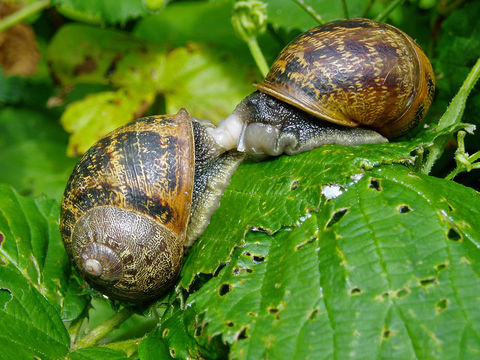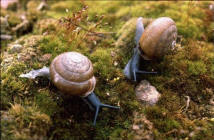
Reproduction
Not much has been discovered about Mesodon elevatus reproduction and life history. Therefore, much of this information is general information about gastropods and pulmonates.
 Common
to all most pulmonates, Mesodon elevatus are hermaphrodites
meaning they can produce both egg sperm(Dourson,
2010). Their ovotestes are the organ responsible for producing both
egg and sperm (Wilbur, 1984). For
fertilization to occur the mates will line up in opposing directions in
order for the genital pores to line up properly (Hotopp
et al, 2006). Once lined up the penis, a muscular organ is used to
transfer the sperm to the mate, by inserting it into the partner’s
genital pore (Wilbur, 1984). In order to
avoid self-fertilization, most land snails exchange spermtophores, which
is essentially a packet of sperm (Hickman et
al. 2012). When spermtophores reach the inside of the other
mate, sperm will be released and will fertilize the partner’s eggs, and
genetic material is exchanged (Hotopp et al,
2006).
Common
to all most pulmonates, Mesodon elevatus are hermaphrodites
meaning they can produce both egg sperm(Dourson,
2010). Their ovotestes are the organ responsible for producing both
egg and sperm (Wilbur, 1984). For
fertilization to occur the mates will line up in opposing directions in
order for the genital pores to line up properly (Hotopp
et al, 2006). Once lined up the penis, a muscular organ is used to
transfer the sperm to the mate, by inserting it into the partner’s
genital pore (Wilbur, 1984). In order to
avoid self-fertilization, most land snails exchange spermtophores, which
is essentially a packet of sperm (Hickman et
al. 2012). When spermtophores reach the inside of the other
mate, sperm will be released and will fertilize the partner’s eggs, and
genetic material is exchanged (Hotopp et al,
2006).

Once this has occurred the snails will lay their eggs. When leaving the body of the snail the eggs are coated with a mucus like substance for food and protection of the developing egg (Hotopp et al, 2006). Due to the fact that laying eggs in too dry of areas is the leading reason why the eggs don’t survive, land snails will lay their eggs in damp or moist places (Wilbur, 1984). The eggs of pulmonates also contain granules of calcium carbonate in order to help in development (Craig et al. 2004).
In addition, all pulmonates go through the process of torsion, which rotates the anus from the posterior section of the body to the front of the body (Hickman et al. 2012). In other words once torsion is completed the anus opens above the head of the snail (Hickman et al. 2012). According to Brown 1991, most pulmonates have shorter life cycles and in order to compensate for that they reproduce more often and produce more young.
Previous: Nutrition Go Home Next: Facts